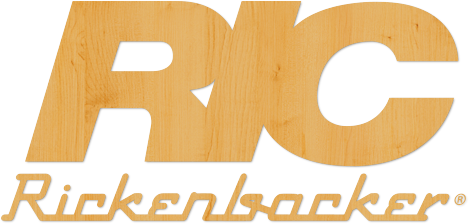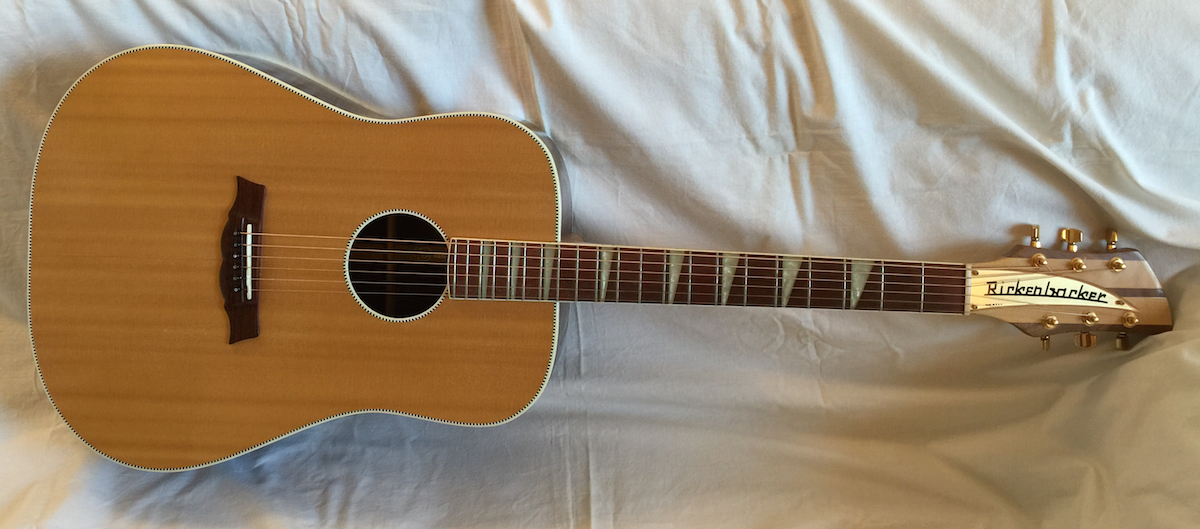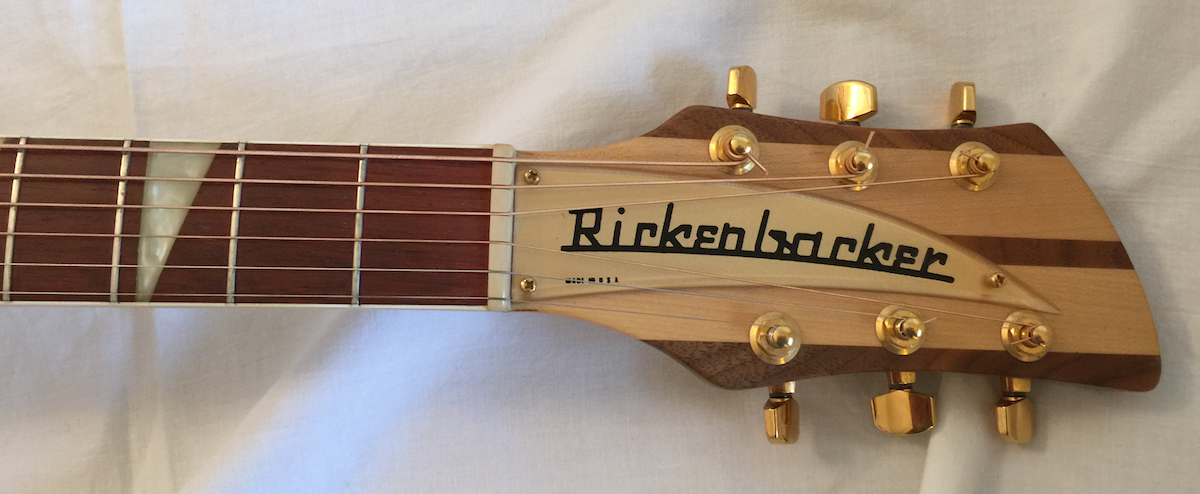An acoustic oddity - The Rickenbacker 730S Shiloh
 Prelude, part 1 - When I was in college in the mid-90s, all I wanted was a Rickenbacker electric guitar. While most 20-year old guys have pin-ups of women in bikinis in their room, I had a picture of a blonde Rickenbacker 381 on my wall. By the late-90s I was fortunate to be able to get a Rickenbacker 360 (see here), but gradually moved away from playing electric guitar and found the 1-5/8" nut width to be too small, so it moved on to a new home. However, as a fan of the Beatles, the Byrds, Tom Petty, Susanna Hoffs, and the Who, I've always had a soft spot for Rickenbackers.
Prelude, part 1 - When I was in college in the mid-90s, all I wanted was a Rickenbacker electric guitar. While most 20-year old guys have pin-ups of women in bikinis in their room, I had a picture of a blonde Rickenbacker 381 on my wall. By the late-90s I was fortunate to be able to get a Rickenbacker 360 (see here), but gradually moved away from playing electric guitar and found the 1-5/8" nut width to be too small, so it moved on to a new home. However, as a fan of the Beatles, the Byrds, Tom Petty, Susanna Hoffs, and the Who, I've always had a soft spot for Rickenbackers.
Prelude, part 2 - I love mahogany guitars; my main players the last few years have been a Collings D1ASB and some various Martin D-18s (see here, here, and here). I tend to prefer mahogany guitars to rosewood, but over the last few months, the latest bout of GAS had me thinking about rosewood guitars as a way of rounding out my tonal palette. Something with a bit more bottom end than my other guitars, without getting tubby (like some rosewood Martins, at least to my ear). Given my taste for nice Martins and boutique instruments, I spent way too much time browsing at the usual rosewood suspects online: various flavors of new and vintage Martin D-28s, Collings D2Hs, Santa Cruz D/PWs and Tony Rice models, and similar offerings from Huss & Dalton and Dana Bourgeois. Sadly there aren't many good guitar shops in my neck of the woods, so I had resigned myself to waiting for the next time we took a roadtrip or taking a flyer on an online puchase.
* * * * *
Today was the semi-annual Philadelphia guitar show. I usually go to a least one of shows each year, but until last year I had never purchased anything there. This year there were some particular interesting guitars, including a 1947 D-28 (with a refinished back; $8.5k), a 1961 D-21 (~$6k), a 1947 Gibson J-50 ($6.5k), a 1950 J-50 (refinished back; could have been purchased for under $4k), a 1995 custom Martin HD-28S (i.e., 12-fret; didn't ask, but it should have been in the $2-2.5k range), a Gibson Jackson Browne model (i.e., a Roy Smeck-style guitar; $4.1k), a Collings 0002HBaaSB (or some such acronym; a 12-fret 000 with a sunburst sitka top and nice Brazilian rosewood back and sides; $6.8k), a 1953 Martin D-18 (I lusted for this same guitar last time I was at the show, but at $10k it's out of reach and not that much nicer than my '56 D-18), and a Weissenborn Style 4 Hawaiian guitar from the late-1920s ($4k). Other than the Martin HD-28S, most of these are out of my league at this point, so after wandering around the show for a couple of hours I decided to make one more loop around the hall before leaving.
I usually don't pay much attention to the booths that are primarily stocked with electric guitars, but there is usually a vender that specializes in Rickenbackers at the show, and given my affinity for them, I usually at least walk by. I was about to head home when I saw one of my guitar unicorns (i.e., super-cool, but pretty much don't exist): a Rickenbacker acoustic guitar. WTF? Rickenbacker makes acoustic guitars?

I've vaguely known about these Rickenbacker acoustics for years, but have never seen one in the flesh. And I always figured that (a) they wouldn't sound that good (at least compared to the Martins and Collings that this guitar snob tends to prefer), and (b) that the necks would be too small (they are spec-ed with a 1-5/8" neck like their electric siblings). But how often do you get the chance to play a Rickenbacker acoustic guitar? So I asked if I could take a strum...
It's a Rickenbacker 730S Shiloh, dating from November 2000; a dreadnought with a sitka spruce top and Indian rosewood back/sides, a maple and walnut laminated neck with a rosewood fretboard bound in white and sporting the classic pearloid "shark fin" inlays (very similar, in fact, to my departed 360), with gold Schaller tuners on the traditional Rick-shaped headstock, a rosewood bridge, and white binding with a classy black/white checkered purfling around the body and soundhole. It just oozes with cool.
Holy hell! This thing is an absolute cannon! But the floor of guitar show is always uber-loud thanks to all the wankers cranking up amps (yes, I did hear more than one asshat playing the intro to Stairway today) and I couldn't get a good sense of the tone of the guitar other than sensing that it didn't suck. So I offer to leave my drivers license with the seller so he'll let me take the guitar to a back room that is tucked away adjacent to the men's restroom, where at least it's a bit quieter.

First, the neck doesn't feel tiny in my hands. I prefer 1-3/4" necks usually, and can live with some 1-11/16" necks like the one on my '56 D-18. But I can't believe that I'm finding this 1-5/8" neck to be very comfortable. How can that be? My hand doesn't deceive; the Rickenbacker actually measures at 45mm, which is a smidge over 1-3/4" (yes, this geek carries a small ruler, along with a kit of flat- and fingerpicks, capos, a bar for playing lap steel, and a tuner, when going to the guitar show). So much for the specs on the Rickenbacker page which shows a 1-5/8" neck (the specs also show a 25" in scale, but this guitar measures 25-5/16"). The frets are low and flat, like (no surprise) an electric guitar, which takes a bit of adjustment. Cosmetically it's in excellent condition; one small ding on the top and a well-repaired center-seam separation.
It's a very even sounding guitar, although the bass definitely has some thump and sustain to it. It's loose without being tubby. The trebles are not as biting as my Collings D1A, but it has more sparkle and shimmer (heck, it's a Rickenbacker, so it's supposed to!). I'm looking for something different than my Collings and Martins, and it is. It probably wouldn't be my first choice for playing lead in a bluegrass jam (again, that honor goes to my D1A), but it will make a great rhythm and strumming guitar.

Someone at the Philly Guitar Show snapped this picture of me playing the Shiloh, and I found it on the Rickenbacker Guitars and Basses Facebook group.
The Shiloh 730S retailed new for $2298 in 2000 (see price list below), and $2529 in 2005 (according to a site I found online).
Here's what Wikipedia says about Rickenbacker acoustics:
Rickenbacker has produced a number of uniquely designed and distinctively trimmed acoustic guitars. Although a small number of Rickenbacker acoustics were sold in the 1950s and were seen in the hands of stars like Ricky Nelson and Sam Cooke, the company concentrated on their electric guitar and western steel guitar business from the early 1960s onward. From about 1959 through 1994, very few Rickenbacker acoustic guitars were made.
In 1995, an effort was made to re-introduce Rickenbacker acoustics, with factory production beginning in their Santa Ana manufacturing facility in 1996. Four models of flat top acoustic Rickenbackers were depicted in factory literature (maple or rosewood back & sides, jumbo or dreadnaught shape). Each of these four models was also available in both six- and twelve-string configurations, yielding a range of eight distinct instruments (The 760J "Jazzbo," an archtop model, was only built as a prototype, with three examples known to exist.) It is estimated that fewer than 500 Rickenbacker acoustic guitars were built before the factory shut down the acoustic department in mid-2006.
 Rick Nelson with James Burton, James Kirkland, and a Rickenbacker 385 circa 1958.
Rick Nelson with James Burton, James Kirkland, and a Rickenbacker 385 circa 1958.
 Jim Reeves and the Blue Boys, circa 1961, with their matching Rickenbackers.
Jim Reeves and the Blue Boys, circa 1961, with their matching Rickenbackers.
This page shows some pictures of acoustic guitar construction at the Rickenbacker factory. It looks like the braces on the top are tapered.
My understanding is that these acoustic guitars were built in the Rickenbacker factory from the mid-90s until about 10 years ago, when an individual luthier starting builing custom acoustics for Rickenbacker. In addition to the archtop 760J "Jazz-bo", there were four models available from the Rickenbacker factory, each in 6- and 12-string configurations (with the same standard finishes as their electrics, e.g., Mapleglo and Fireglo):
- 700C "Comstock" - Jumbo/maple body
- 700S "Shasta" - Jumbo/rosewood
- 730L "Laramie" - Dreadnought/maple
- 730S "Shiloh" - Dreadnought/rosewood
I found a brochure about the 700 series guitars circa 2000, scanned it, and included it at the bottom of this post. There are a few interesting differences between the Shiloh pictured in the brochure (and the corresponding specs) and this one:
- As previously mentioned, this Shiloh has a 1-3/4" neck width at the nut, while the brochure lists it as 1-5/8"; similarly, the scale lengths are different (measures 25-5/16" vs. listed as 25").
- The one pictured in the brochure has a white truss rod cover, this one is gold.
- The bridge shape is different; the sides on this one flair out, and the top is slightly curved. It's also rosewood; the one in the brochure appears to be ebony and is more rectangular.
- This one has black, rather than white, bridge pins, although admittedly these could be non-original. But most, although not all, of the other Shilohs I found pictured online also have black pins.
- The one in the brochure has chrome, rather than gold, tuners.
- While they both have 21-frets, the fretboard on one pictured in the brochure ends before the soundhole and the end is straight; this one overlaps the fretboard and is curved. This means that the bridge placement varies (even when considering the difference in scale length).









 Saturday, November 21, 2015
Saturday, November 21, 2015
Reader Comments